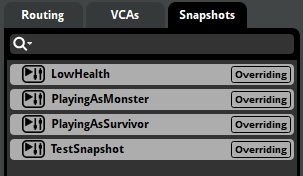
The Audio of Shatter Keep
A shifting horror soundscape that amplifies and enhances the tension of the hunt.

Platform: PC
Engine: Unity
Additional Tools Used: FMOD, FL Studio 20
Team Size: 12 (Remote)
Duration: 24 weeks
Released on Steam on May 7th, 2021.
Responsibilities: Soundtrack Composition, Voice Recording, Foley Recording, Effect Sourcing, Sound Editing, Mixing, Mastering and Implementation (+ additional responsibilities as Lead Artist and Animator).
Game Summary
Shatter Keep is an asymmetrical multiplayer game where 3 survivor players try to escape the castle and 1 player attempts to eliminate them. Survivors must complete a list of objectives to open the castle exits while arming traps, lighting torches and avoiding the monster before the timer expires.
Audio Demo
Soundtrack Composition
Audio was very important to the team, as it was meant to both establish and reinforce the tense atmosphere that we were attempting to portray in our game. To this end, the soundtrack features 2 main pieces of music: the menu theme, “Darkness Unfolding” and the gameplay theme, “The Hunt.” Both tracks utilize drawn out strings and sinister ambiance to set and reinforce the tense, horror inspired roots of Shatter Keep. The gameplay theme, was composed to be dynamic, and constantly evolving to reflect the state of the game. The theme was written in FL Studio as several different layers that are added or pulled back dynamically depending on certain actions.

Above: The layers of the main gameplay theme within FMOD. Many of these layers can be dynamically added or stripped away based on the current state of the game session.
As survivors are picked off one by one, the intensity of the background music ramps up, from subdued and moody to chaotic and oppressive. FMOD is utilized to facilitate the reactive soundtrack, and to also allow for certain extradiegetic sounds to be played in time with the background track. These special sounds are reserved for important alerts with somewhat musical components, such as the “Survivor Downed” and “Survivor Revived” sound effects.

Above: The global alert setup for both the “Survivor Downed” and “Survivor Revived” sound effects that ensure they play in time with the background music whenever they fire off.
To listen to selections from the soundtrack, click here:
Sound Design
Sound design for Shatter Keep had a strong focus on incorporating realistic, diegetic sounds and environmental cues to build both tension and atmosphere. Extradiegetic effects are used sparingly, primarily to notify players that important events have occurred, such as a survivor dying or an objective being completed. A large portion of sound effects were recorded, produced, and mixed in-house (which was a particularly difficult feat given the game’s shoestring budget and the fact that development occurred during the COVID-19 lockdowns). Outsourced sound was found in the public domain, then edited and modified to ensure that it fit within the rest of the game’s soundscape.
Dynamic Effects
Several of Shatter Keep’s effects were set up to change dynamically based on conditions within the game. Footstep sounds would pull audio clips from a bank of potential sounds based on the surface that the player was walking on. Effects such as attacks had multiple versions of the effect that would play based on whether or not the attack connected with another player or not. This was all to keep the soundscape from becoming stale during long sessions, and to provide solid auditory feedback for actions occurring in game.

Above: The audio banks for the monster’s footprints. The sound of the played footstep is controlled by a parameter that changes based on the surface that the player is walking on when the effect fires.
The Voice of the Monster
The only character with audible vocalizations in Shatter Keep is the primary antagonist, the Monster. Voice lines were recorded and acted by myself. I wanted the monster to have this raspy, feral voice, almost like simply being alive brought it great pain and anger. Once I had the raw voice lines for all the sounds I would need, I then created multiple different layers of the vocals and adjusted the pitch on each layer to give the monster an uncanny, polyphonic voice. The end result is something quite unsettling:
Mixer Snapshots
Shatter Keep’s audio system uses the snapshot system to adjust the audio mix on-the-fly based on the player’s current status in game. Monster and Survivor player’s have slightly different general mixes of the game, where Monster sound effects are slightly louder than Survivor sound effects to those who are playing Survivor. The inverse is true for the Monster player. Also, when a player is damaged, they enter a different mix state that emulates the “close to losing consciousness” effect seen in many FPS games, where the audio becomes muffled when the player is low on health.

Above: the various mixer snapshots for different player statuses, in addition to a test snapshot.